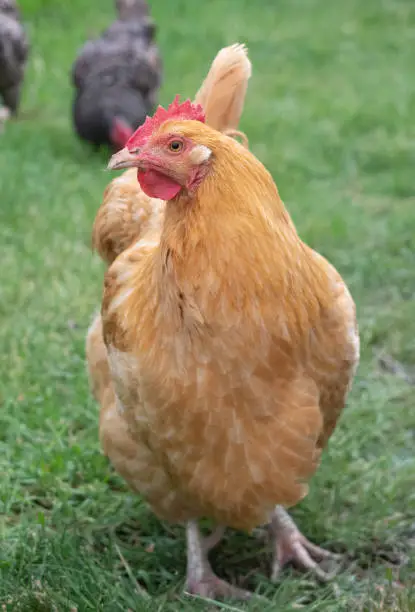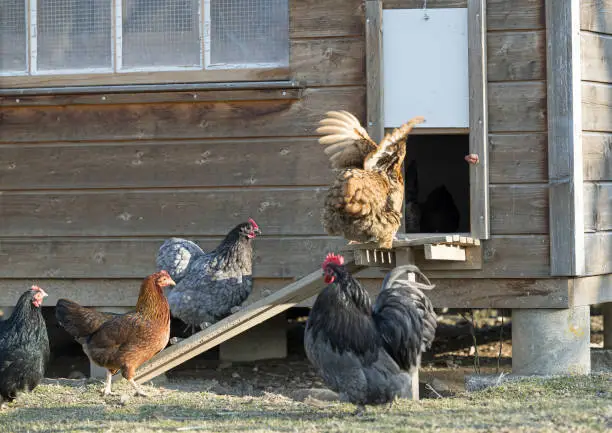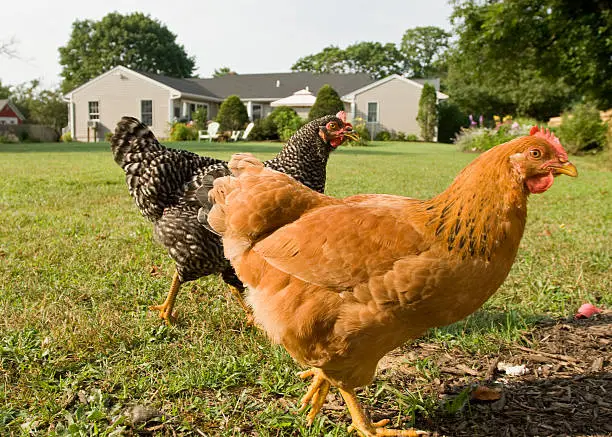Orpington Chicken Breeds: Characteristics, Origin, Breed Info, and Lifespan
Orpington Chicken Breeds are beautiful and stately royal birds well-formed with their soft and fluffy feathers that give them a perfect framework.
In this article, we mentioned the characteristics, history, breed information, and specs that made this bird Queen Elizabeth’s favorite chicken.
Let’s start with what the Orpington breeds are.
What is an Orpington Chicken?

The Orpington is a hybrid chicken breed of chicken that originated in the United Kingdom due to the need for a large black poultry breed. They are all-purpose birds, meaning that they are good egg layers, tasty meat chicken, and calm bids for poultry shows
This chicken was bred by William Cook of Orpington, Kent, in southeast England, hence the name. He intended that the chickens be reared for egg and meat production, but because of their beauty, they soon turned to show birds.
As Queen Elizabeth’s favorite and one well connected with the British royal family, it is treated like royalty.
Origin of the Orpington Chicken Breeds
Country of origin – United Kingdom
In 1886, William Cook cross-bred Langshans, Minorcas, and Plymouth Rock Chickens to originate the Black Orpington. This new hybrid bird became popular in 1895 after the breed was exhibited at the Madison Square Gardens.
This experimental breeding also led to the development of Orpington chickens with different colors including blue, buff, white, and splash. These were the original colors of Orpington chicken breeds that were recognized by the American Poultry Association (APA). Asides from these “originals”, there are also other varieties of Orpington chickens worldwide.
The most common color of Orpington chickens is the buff variant. Herman Kuhn of Germany the twentieth cent founded the Bantam variety. The Bantam was smaller but had more appealing colors than the standard ones.
The color varieties of the Bantam Orpington chicken are black, white, buff black laced, buff, blue laced, buff Columbian, birchen, barred, and red. Despite their color differences, the Bantam version still retains the properties of the standard birds.
The poultry club for the Standard Orpington chicken breeds in the UK is known as the Orpington Club which was later merged with the Orpington Bantam Club in 1975. In America, the club is tagged as “The United Orpington Club” while in Australia, the Australorp breeder’s club is the Orpington Club of Australia.
Uses of the Orpington Chicken Breeds
Orpingtons are known to be good egg-laying chicken breeds. They lay 175 to 200 medium to large light-brown eggs on an average each year; or about 3-5 eggs in a week. This number can reach up to 340 eggs yearly if the chickens are properly cared for.
Since most breeders select the birds for poultry shows based on their looks rather than their productive abilities, this can lead to their reduced egg-laying in a year.
Characteristics of Orpington Chickens
Orpington chicken breeds having originated as a hybrid of three chicken varieties – the Langshan, Minorca, and Plymouth Rock Chickens are most likely going to share similar characteristics with these birds. Here are some peculiar properties of Orpington Chickens:
1. The Body Skeleton of Orpington Chickens
The Orpington breed possesses a unique body shape. They are heavy and curvy with a U-shaped underline and short back.
2. Feathers of the Orpington Chicken Breeds
The feathers of Orpingtons are fluffed out, broad, and smooth; causing them to look larger than they are. The large body frame outlook of Orpington chickens is much attributed to their feathers and not the bulk of their bodies.
These feathers may reach up to their legs but the legs are not essentially feathered.
3. Comb Type and Wattle Color of the Orpington Chicken
The combs of these birds are single with five fork points. It is rose-like, medium-sized and we’ll be seated on a small head. The comb, wattles, and earlobes have the same red color.
4. The Skin of Orpington Chickens
Of the major defining characteristics of the Orpington breed; is their neatness is outstanding. These English birds hide dirt and soot perfectly, which was the initial plan of William Cook. They maintain their white skin flawlessly. The beak, shanks, feet, and legs are pinkish-white while their eyes have reddish bay color.
5. Egg Colour of Orpington Chicken Breeds
Their eggs are brown and large.
6. Weight of the Orpington Chicken Breeds
Usually, the Orpington chickens have varying weights depending on each hybrid variety. The Poultry Club of Great Britain noted that the Orpington males weigh 3.60 – 4.55 kg. Orpington hens weigh about 2.70 – 3.60 kg.
7. Habitat and Environment of an Orpington Chicken Breed
Orpington chickens work well in urban areas and the suburbs. They are well suited in a coop space of about 4 square feet. The nesting box can be 12×12 inches such that the roaming or perching space is 8-10 square feet. This would allow them to stretch easily without feeling confined.
You can also let them perch freely around your garden on cabbage piñatas and leaf piles.
8. Growth rate of Orpington Chickens
Since the Orpingtons are generally large birds, their growth rate is similar to other chickens like the Sussex Chicken Breeds. You just have to feed the chicks with a proteinous feed of about 20%. You can reduce the protein content to 16% when they are up to 16 weeks. To maintain their health and prevent obesity, you may want to always look out for their increasing weight.
The Lifespan of Orpington Chickens
The average lifespan of Orpington chickens is 8 years, however, they can live longer than that if properly managed.
Varieties of the Orpington Chicken Breeds
The Orpington Chickens have two varieties established by William Cook and Herman Kuhn. The standard large fowls were first bred by William Cook while the Bantam varieties were by Herman Kuhn.
Standard Varieties of the Orpington Chicken Breeds:




Bantam Varieties of the Orpington Chicken Breeds:



Breed Information of the Orpington Chickens
Specs of the Orpington Chicken Breeds
Orpington chickens are royal birds that come with lots of benefits. Below are some of the reasons why we think the Orpington chicken breed would be a perfect addition to your farm:
- The Orpingtons are robust, healthy, and not sickly birds. They rarely suffer from common chicken diseases but are prey to chicken parasites like lice, ticks, and worms.
- Orpington chickens are heavy birds and as such, very poor flyers. Because they are heavy, flying would rarely come to their mind. You wouldn’t have to look around for them so much when it’s time to return them to the poultry house
- Orpingtons are not noisy birds but an outburst if there is any cause for alarm especially if they meet a predator.
- The Orpington breed is an all-purpose bird. Good for eggs, meat, and exhibition shows.
- Orpington chickens are calm and docile pets. They are great for any kind of animal lover; kids and adults alike.
- The Orpington chickens are brooders and wonderful mother hens. They can become the matrons of your farm, warming the eggs with their fluffy feathers. The Orpington chicken breed can even help hatch other eggs that are from theirs.
Disadvantages of the Orpington Chicken Breeds
On the flip side, the Orpington chickens also have their challenges, which include:
- Orpington chickens are easily bullied by other birds like the Rhode Island Red and the Ayam Cemanis because of their non-aggressive nature
- Orpingtons are susceptible to coccidiosis and sometimes need to be fed with medicated feeds which are quite expensive.
- As Orpingtons are very neat birds, they also require high maintenance to get rid of lice and ticks spots. Their routine spot treatments should be done every week
- If your Orpington chickens become overweight, they may suffer from prolapse and egg binding.
- If your Orpington chickens become overweight, they may suffer from prolapse and egg binding.
Conclusion
From the details above, you must have seen the good sides and bad sides of the Orpington chickens. It is good to note that these characteristics are on average which means that your Orpington chicken may have simar but different properties from the ones highlighted.

![Top Feeds Price List in Nigeria ([year]) Top feeds price list in nigeria](https://eucarlagro.com/wp-content/uploads/2023/03/Top-Feeds-Price-List-in-Nigeria.jpg)




